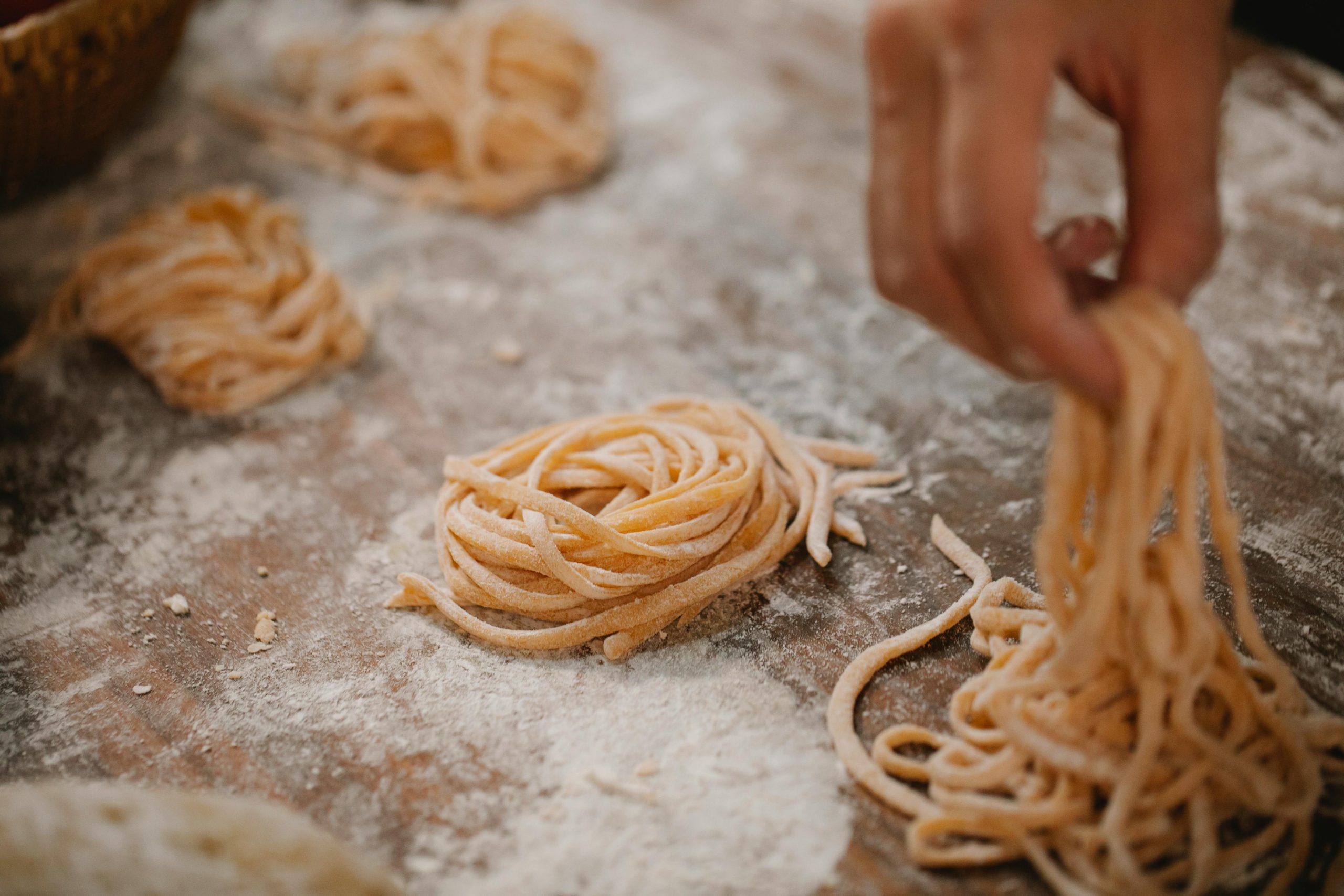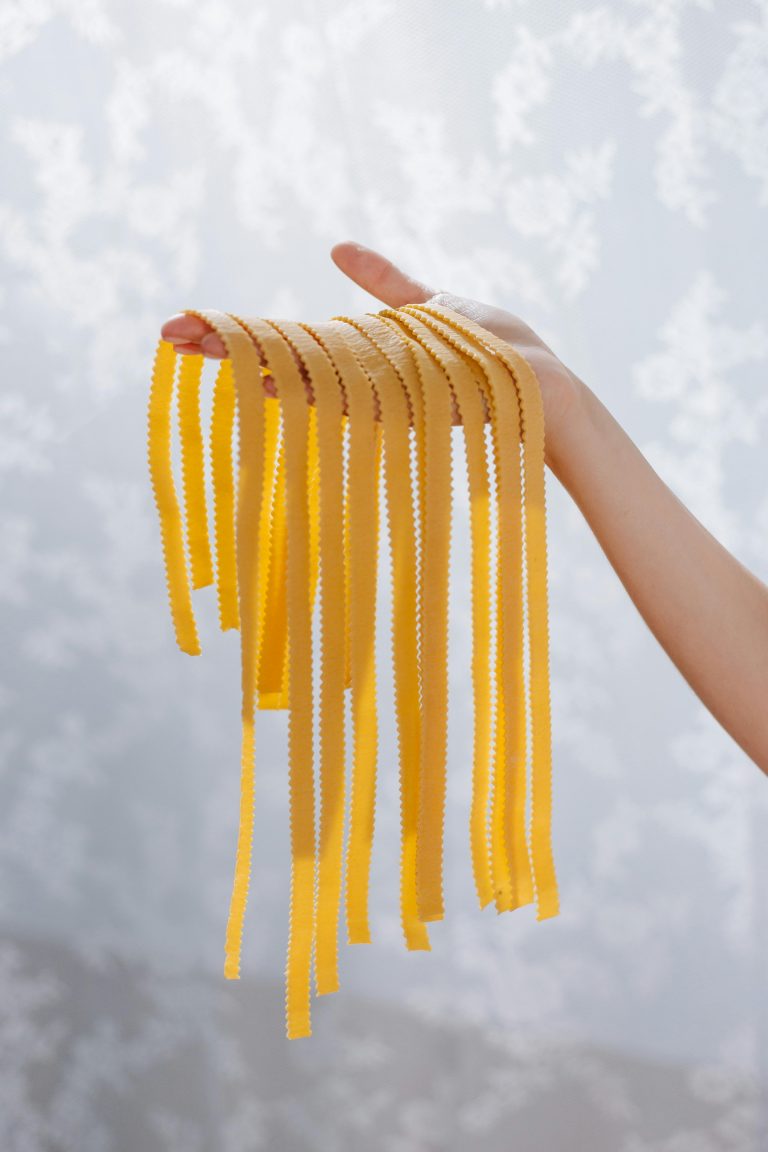Fresh pasta is one of the luxurious culinary creations you can make at home. Making fresh pasta instead of buying the store-bought stuff might seem intimidating at first, but with some patience and practice, you will find out that it’s pretty easy. However, unlike store-bought, storing fresh pasta takes a little more effort (but is 100% worth the time spent).
Ahead, we’ll cover everything you need to know, from drying fresh pasta, storing fresh pasta in the fridge and how long it lasts, to freezing fresh pasta and common mistakes.

How to dry fresh pasta
Although extremely tricky to replicate at home, drying freshly made pasta is an option. Commercial outfits invest quite a lot of time and resources in their drying methods to produce top-quality pasta that is safe to eat and has a long shelf-life. If dried improperly, you may end up with:
- Mouldy pasta from excess moisture or humidity (especially egg-based doughs),
- Brittle and cracked pasta, and
- A similar texture to that of commercially-made pastas, not the silky soft texture you get with freshly made pasta.
However, if you’d like to master the technique (for when an apocalypse might happen one day), here’s what you’ll need:
- Pasta drying rack, wooden board, baking sheet, or hangers
- Rice flour
- Freshly made pasta
Drying steps
- Choose a drying method: the standard pasta rack you find in stores or online is the most recommended, but any other method listed above will also work. You want to make sure that there is enough airflow between the shapes for them to dry thoroughly.
- Arrange the pasta: Dust and coat the pasta shapes with a good amount of rice flour to prevent sticking. Then, for spaghetti or fettuccini-type shapes, hang them on a pasta rack or hangers. For penne-type shapes, arrange them in a single layer on a wooden board or baking sheet. Make sure there is enough room in between each strand or shape for air to flow freely.
- Allow time to dry: Leave the pasta to dry out thoroughly. Depending on the heat and humidity of your kitchen or workspace, this could take 12 to 24 hours or longer. As soon as your pasta snaps when you break it (not flexing or bending), it’s dry enough.
- Store dried pasta: Place pasta in an air-tight container and store in a cool, dry, and dark cupboard (just like you would commercially-made pasta).
How long does it last?
Properly dried fresh pasta can last for up to two to six months.
How to refrigerate fresh pasta
Storing fresh pasta in the fridge is an easier option than drying, but it doesn’t have a very long shelf life.
Storing fresh pasta
Here’s what you’ll need when you’ve made a big batch of fresh pasta strands, like spaghetti or tagliatelle, or handmade shapes, like farfalle or orichietti, and you’ve got a portion or two leftover:
- A baking tray or rectangular container
- Rice flour
- Clean dishcloth or plastic wrap
Steps:
- Dust each strand or shape with a generous amount of rice flour to prevent sticking.
- For strands and homemade shapes: Collect enough pasta for a portion and arrange it into a nest, and lay it out on the baking tray or in the container. Cover with a dishcloth or plastic wrap.
- For ravioli or other filled pasta: Dust both the tray or container and filled pasta with rice flour. Lay the pasta out in a single layer (use more trays or containers if you need to) and store in the fridge uncovered. Filled pasta has a moist filling that, if covered, may seep into the outer layer and create a sticky mess.
- Store in the fridge.
How long does it last?
Refrigerated pasta can last for up to three days; however, for maximum texture and flavour, consume within one day. If the pasta has mould, a sour taste, or off odours, discard it immediately.

How to freeze fresh pasta
If you feel like you won’t get to consume fresh pasta within three days, consider freezing it instead. Strands of pasta aren’t the best candidates for freezing, as they tend to become brittle and crack when cooked. The best shapes to freeze include farfalle, orichietti, and filled pasta, like ravioli or caramelle. Here’s what you’ll need:
- Boiling, salted water
- An ice bath
- A strainer
- A lined baking tray or rectangular container
Steps:
- First, blanch the pasta for about three to five minutes. You don’t want it to be al dente, nor cooked through.
- Transfer immediately to an ice bath to stop the cooking process.
- Drain and leave to dry out for a few minutes.
- Transfer to a lined tray or container and freeze for at least eight hours or overnight.
- Once frozen, transfer the pasta to a labelled zip-lock bag or air-tight container to prevent freezer burn and save storage space.
- Boil from frozen, making sure to add an extra minute or two to the timer to account for the temperature change in the pot.
How long does it last?
If frozen correctly, pasta will last for up to eight months (hopefully with no loadshedding or power outages).
Common mistakes to avoid
- Not enough flour: If the pasta hasn’t been coated in enough rice flour, it will stick and cause a sticky mess.
- Storing it uncovered: Uncovered strands or handmade shapes stored in the fridge or freezer will absorb other odours and flavours close by (garlic or banana-flavoured pasta, anyone?), resulting in an unpleasant taste.
- Overpacking containers: When packing trays or containers with loads of pasta, you’ll end up with a mushy mess and an altered texture when cooking. It’s crucial to leave enough space in and around pasta portions and shapes to prevent this.
- Leaving the dough out: If raw dough has been left out, uncovered, at room temperature for more than two hours, it puts it at risk of harmful bacteria and microorganisms growing. Additionally, when trying to shape dough that’s been left out, you will struggle with the crust that’s formed. This changes the texture for the worse. Always cover dough with a clean, damp cloth or plastic wrap if it needs to rest at room temperature or while you’re working with it. Do not keep fresh dough out for more than an hour to prevent the risk of it going off.

